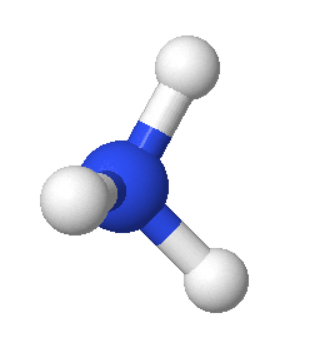
First name
Last name
Matrikelnr.
Problem 1
Ammonia consists of one nitrogen atom and three hydrogen atoms.

(a) What is the molecular orbital Hamiltonian for ammonia?
(b) A nitrogen atom has seven protons. What linear combination of atomic orbitals would you use as a trial wavefunction to calculate the molecular orbitals of ammonia?
(c) How many molecular orbitals would be calculated from your trial wave function from (b)? How many of these molecular orbitals would be occupied in the ground state of ammonia?
(d) Are the N-H bonds σ-bonds? π-bonds? polar bonds? single bonds? double bonds? ionic bonds? covalent bonds? hydrogen bonds?
(e) How many translational, vibrational, and rotational modes does ammonia have?
(f) Would the spacing of the rotational energy levels of ammonia be larger or smaller than the spacing of the rotational energy levels of H2? Why?
Problem 2
Copper has one atom in the unit cell and the Bravais lattice is fcc. The lattice constant of the conventional unit cell is 3.615 Å.
(a) Draw the conventional unit cell of copper.
(b) What is the shape of the Wigner-Seitz cell for copper?
(c) A copper crystal is placed in an x-ray diffractometer. The wavelength of the x-rays is 1.54 Å. X-ray photons in the primary beam are not diffracted, $\Delta \vec{k}=0$. What is the minimum (nonzero) change in wavevector $\Delta \vec{k}$ possible in this experiment? What is the maximum change in wavevector $\Delta \vec{k}$ possible in this experiment?
(d) Sketch the phonon dispersion relattion for copper along $L-\Gamma-X$. ( $\overline{\Gamma L} < \overline{\Gamma X}$ ).
(e) The valence orbitals of copper are the 3d orbitals and the 4s orbital. The 4s orbitals have the largest radius and therefore the largest overlap between neighboring atoms. This large overlap results in a wide bandwidth of the 4s band which can be approximated using a nearly free electron model. Use the empty lattice approximation to sketch the electron dispersion relation for the copper 4s band along $L-\Gamma-X$.
(f) The five 3d orbitals do not overlap as much as the 4s orbitals so the bandwidth of the 3d bands is smaller. They cut through the middle of the 4s band. Add the 3d bands to the drawing above.
(g) The atomic configuration of copper is 3d104s1. Use this information to draw the chemical potential in the dispersion relation above.
(h) Sketch the electronic density of states of copper based on your drawing of the electron dispersion relation.
(i) Why is copper a good thermal conductor?
Problem 3
The properties of some semiconductors are listed in the table below.
$N_c$ | $N_v$ | $E_g$ | |
Si (300 K) | 2.78 × 1025 m-3 | 9.84 × 1024 m-3 | 1.12 eV |
GaAs (300 K) | 4.45 × 1023 m-3 | 7.72 × 1024 m-3 | 1.424 eV |
4H-SiC (300 K) | 1.7 × 1025 m-3 | 2.5 × 1025 m-3 | 3.3 eV |
(a) What is the chemical potential for intrinsic 4H-SiC measured from the top of the valence band at 300 K?
(b) Draw the density of states for 4H-SiC as a function of energy near the top of the valence band and the bottom of the conduction band. Explain how you used the data from the table above to make this drawing.
(c) What is the electron concentration in the conduction band of 4H-SiC at 300 K?
(d) Describe the relationship between the effective density of states and the effective mass. (You don't need to give the formula, just describe in words how they are related.)
Quantity | Symbol | Value | Units | |
| electron charge | e | 1.60217733 × 10-19 | C | |
| Planck's constant | h | 6.6260755 × 10-34 | J s | |
| Boltzmann's constant | kB | 1.380658 × 10-23 | J/K | |
| electron mass | me | 9.1093897 × 10-31 | kg | |
| Bohr radius | a0 | 0.529177249 × 10-10 | m | |
| atomic mass constant | mu | 1.6605402 × 10-27 | kg | |
| permittivity of vacuum | ε0 | 8.854187817 × 10-12 | F m-1 | |
| permeability of vacuum | μ0 | 4π × 10-7 | N A-2 | |
| speed of light | c | 2.99792458 × 108 | m/s | |
| Stefan-Boltzmann constant | σ | 5.67051 × 10-8 | W m-2 K-4 | |
| Avogado's constant | NA | 6.0221367 × 1023 | mol-1 |